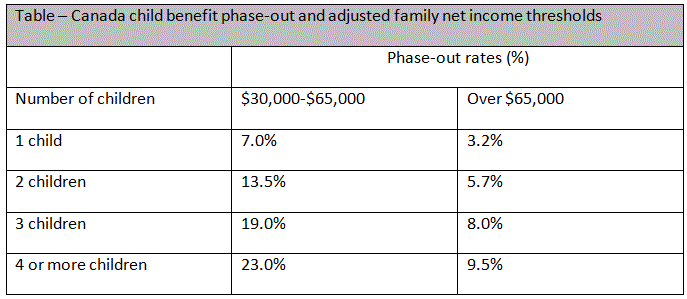What does the Canada Child Benefit mean for parents?
Eligible parents recently received their first payment under the new Canada Child Benefit (CCB) program that was introduced in the Liberal government’s first federal budget – and questions will surely arise about the details of the program.
Being a parent is the quintessential labour of love, though every parent knows that raising a child is costly. Every government knows it too, which is why the provision of support to young families has long been a feature of public finance. But opinions on the manner of providing that support vary from time to time, from person to person and from one political party to the next.
This debate was front and centre in last year’s federal election campaign, so it was no surprise that the Liberals took action to change things up. Let’s look at the changes.
Programs being terminated
To fully appreciate the changeover, parents and their advisors need to know what’s ending as much as what’s starting. This is not merely an exercise in purging acronyms from the lexicon; it helps in understanding who is affected, why (from the governing party’s perspective), and how much it will impact household budgets. In this last respect, it should inform the family’s monthly budgeting and longer-term financial planning, including establishing adequate education savings.
The CCB directly replaces the following support programs that made their final payments in June:
- Canada child tax benefit (CCTB)
- National child benefit supplement (NCBS)
- Universal child care benefit (UCCB)
At tax-filing time, the CCB will have the following impacts:
- The family tax cut (the income-splitting tax credit worth up to $2,000) is eliminated after 2015
- The education tax credit and textbook tax credit are eliminated after 2016
- The children’s fitness and arts credits are halved for 2016, and eliminated after 2016
Why the CCB?
Taken together, the CCTB, NCBS and UCCB included taxable and non-taxable amounts, some of which were income-tested and others not. In addition to it being relevant who received the payments, this required consciousness of latent tax obligations, coordination with other benefits and catering to particular family circumstances. For example, at tax-filing time a single parent would have to decide whether to report UCCB income personally, as income of the child for whom the UCCB was received, or as income of an eligible dependant.
The CCB has been positioned as simpler, better-targeted to those in need and more generous to those most in need.
All CCB payments are tax-free, neutralizing income-reporting complications. With income and expenses denominated in the same way – after-tax – there is no mystery around how much tax will be due the following April, and no need to keep a reserve for the purpose. Accordingly, household budgeting becomes more manageable and, as always, the family’s financial advisor can play an important role in pulling that together.
Income-testing applies to all potential CCB recipients. According to the government’s calculations, families with income under $150,000 will receive more through the CCB as compared to the current system, on average receiving $2,300 more.

Source: 2016 Budget Tax Measures, page 9
What can families expect?
Of course no family is average, whether talking CCB or otherwise. What is relevant is the number of children, their ages and the total household income – technically, the “adjusted family net income” (AFNI).
The full entitlement is $6,400 per child under the age of six and $5,400 per child for those aged six through 17. These amounts are reduced by the percentages shown in the table above, as AFNI crosses the $30,000 and $65,000 income thresholds. To recognize the additional costs of caring for a child with a severe disability, there is an additional amount of up to $2,730 per child eligible for the disability tax credit. The phase-out of this additional amount begins at the $65,000 income level.
To illustrate how this operates, assume that a family has two children ages four and seven, and AFNI of $90,000. Their base entitlement is $6,400 + $5,400 = $11,800. The 13.5% clawback applies to the income from $30,000-$65,000 and 5.7% to the excess $25,000. That’s a total reduction of ($4,725 + $1,425 =) $6,150, leaving them with $5,650.
Fortunately, families do not have to do the calculation themselves. The entitlement is calculated by the government based on tax returns filed each April. Allowing for tabulation time, the program cycle runs from the following July to June of the next year.
This post was originally published at Invesco Canada Blog
Copyright © Invesco Canada Blog














